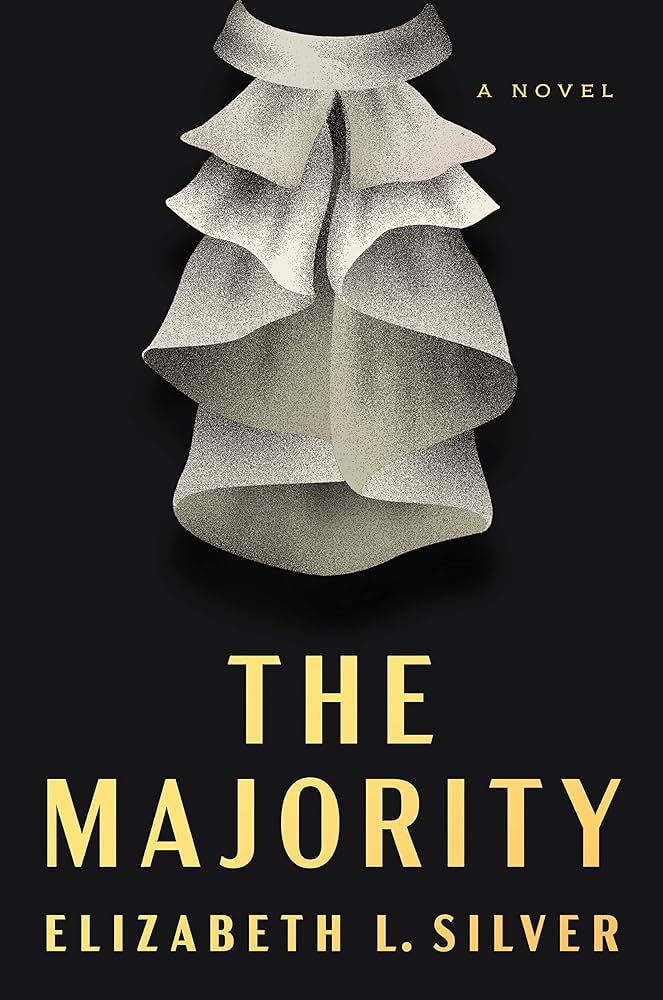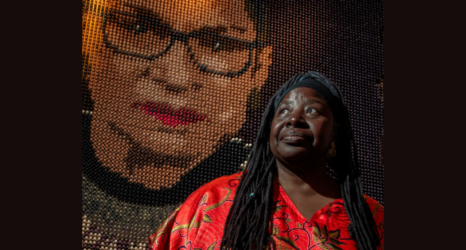
I first met Elizabeth L. Silver years ago when we both taught for Writing Workshops Los Angeles. I was aware she had published both a novel and a memoir (of “medical uncertainty”) but had no idea what else she was working on. When I heard the title of her new book, The Majority, I knew the lone word in the title held layers of resonance.
As someone with an MFA and law degree, Silver is uniquely positioned to explore what the term “majority” means—both its wide definition in relationship to being female, or part of a consensus. She also understands how narrow a majority can be—such as when a single vote tips the balance over on the Supreme Court.
The Majority‘s main character is reminiscent of Ruth Bader Ginsburg, or “The Notorious RBG,” and the reader follows her arduous, yet steady, ascending legal career. The novel reveals an intergenerational weave of feminists still trying—sometimes in impossibly constricted ways—to break down doors, laws and spaces to effect change.
In this book, we see a composite of personal and professional challenges that reflect the path of one character but represent so much more beyond just her.

Elline Lipkin: Sylvia, the novel’s protagonist, says to a potential client whose case she wants to take on (to fight against pregnancy discrimination), “Now women are the majority, and yet we hold almost no power at all. In some small way, perhaps this is a slight chiseling away at that.”
How did you pick the title, and how do you convey what ‘the majority’ means?
Elizabeth L. Silver: The original title for this book was actually ‘Memoirs of a Justice,’ but we changed it to ‘The Majority,’ first to make it clear that this is a work of fiction, and second, to really hone in on many of the themes at play.
On its face, the majority refers to the fact that in our common law system, a judicial opinion that is the majority opinion ultimately becomes the controlling law.
The title also refers to the fact that women are the majority population in America. I was very interested in exploring a world—our current world—where women make up the majority of the population, but are the minority in power. What does that look like intimately, while also examining the larger ramifications for society?
By telling one woman’s story about her path to power, in turn, my goal was to also create a narrative that might be representative for many women.
Lipkin: The number nine is important in the book. Sylvia is one of nine female students admitted to Harvard Law School—which only admitted women nine years before—and later is the first female Supreme Court justice.
How did you work with the contrast between what a small number nine is, yet the powerful effect—both symbolic and actual—even this incremental change can have?
Silver: When I learned that RBG’s class at Harvard Law consisted of nine women, I found it a powerful symbol and wanted to explore that further, given that there are also nine members of the Supreme Court. I wanted to play with the sovereignty of that number—nine as a symbol of power. What’s more, nine is also the highest single digit, so it is as far as a number can go alone before breaking that double-digit glass ceiling, but I may be taking that metaphor a bit too far now.
Lipkin: The protagonist, Sylvia Olin Bernstein, is clearly managing roles that occasionally compete professionally and personally. Her conflict with her daughter reveals she has paid a price.
This book is set in a generation previous to the present day, yet are these pressures still as acute? Are they more personal than institutional? In other words, have times changed? It was striking how often she is at the nexus of unrelenting expectations that pull her in opposing directions and how hard she has to maneuver within these spaces.
Silver: I want to say that these expectations of pitting the personal versus professional have changed in recent years, and in a way, they have—at least on paper.
During Sylvia’s time, women were expressly told they couldn’t have certain jobs and were explicitly excluded formally on the basis of sex. Abortion was illegal (though it is again now in many states), pregnancy discrimination was legal, and women couldn’t have bank accounts in their own name, or exist much beyond the Mrs. to a Mr. Certainly.
Many of those basic elements of independence and autonomy are different now—at least legally. However, socially and psychologically, I’m not convinced that they have actually changed as much as we might have expected when examining the evolution on a granular level. Instead, I see that these issues are masquerading in other forms, such as social bias, lack of parental leave, the mental load for mothers, and so much more. Though pregnancy discrimination is technically illegal, employers can still find ways around that, and as a result, women struggle to maintain their economic independence when there is no paid leave.
What’s more, you cannot legislate behavior, and so bias towards pregnant people and mothers has permeated society just wearing a different dress than, say, legal discrimination in a generation past. Now the injustices are more intimate and personal than legal and institutional.
In the novel, Sylvia, at the forefront of this change, helps to dismantle some of it institutionally, but she still struggles personally—as so many women past and present continue to do.
So much of what we know about people in positions of great influence and power is during that tenure, but I was interested in the life that got them to that throne
Elizabeth L. Silver
Lipkin: Sylvia’s daughter Aviva says to her mother, “Women will still get pregnant, women will still get raped, women will still be mothers when they want to and when they don’t.”
There is an evergreen quality to the issues explored, contrasted with the fight to advance judicial change. Sylvia says, “I did what I could at the time to chip away at the old law. Back then something is what we needed and now something isn’t enough, and so we begin again…”
Is this a perennial struggle or do the goalposts just keep moving—as Sylvia says?
Silver: I think that it is both a perennial struggle and that the goalposts keep changing, which is a good thing. There are certain elements that women will always be pushing up against, but each generation seems to achieve more, and so those goalposts do change, and rightly so. This is progress and it is that perpetual motion of progress that might actually be the constant here: Once you achieve something, you look to the next rung. This is healthy progress for all things in life. Without it, we have stagnancy, or worse, regression.
Lipkin: I was struck by the intergenerational issues among the women in the book.
- Sylvia’s mother, urging her to change the system from within, secretly financing her law degree
- Her cousin, who escaped the Holocaust, presenting a different figure of female ambition and survival (unmarried, an artist)
- Her daughter, who both recognizes and resents her mother’s vision
- Linda, Sylvia’s former roommate and lifelong friend, who reveals to Sylvia how race differentiates their treatment
How did you settle on the roles you wanted these characters to play? Was each important as representative of constraints put upon women, yet in different ways?
Silver: People are often inconsistent; or, perhaps the better way to view inconsistency, is that people change over time. How can they not? Each new interaction and experience changes us, and that will, in turn, change our perspectives. We are influenced for better or worse by those with whom we surround ourselves, and so no character is fully explored or developed without doing the same with her close relationships.
I was also very interested in exploring intersectional feminism and I found it important to depict, as best I could, different people’s experiences during the women’s movement of the ’60s and ’70s. No single person can personify an entire gender’s experience, but each of the women in the novel do represent a different approach to parenthood, to ambition, career and progress—and they all influence Sylvia, who will ultimately have influence on how the laws change for everyone.
Lipkin: When Sylvia says, “If I was to be this experiment, the person with whom they subverted their rules, the rules needed to change. I sat in that room on behalf of all the women who could have been there instead. And I vowed in that moment, never to be blind to them again.”
Sylvia is aware of how she is at the vanguard and the privilege that has landed her there alongside her struggles. I wonder how you wanted to frame the struggle for change for women—working within the system, as she does, but then wanting to take the system down and rebuild it.
Silver: Sylvia struggles with how to best effect change, and she realizes through her own experience and the experiences of those around her how vastly different actions can impact large change. On their own, they don’t always work, but put together in tandem they do.
So, for example, Sylvia works within the legal system to change it, while her mother does so quietly in the domestic sphere, and her friend, Linda, does so outside the law with the written word. They say to each other, “from the outside in, and the inside out.”
There are certain elements that women will always be pushing up against, but each generation seems to achieve more, and so those goalposts do change, and rightly so. This is progress.
Elizabeth L. Silver
Lipkin: You have a law degree and worked as an attorney. Did your experiences filter into this novel? I couldn’t help but think of the “Notorious RBG” when Sylvia is dubbed “the contemptuous S.O.B.” How did Ruth Bader Ginsburg shadow this work as well?
Silver: There have been 116 Supreme Court justices in the United States since its inception in 1789, but only six have been women.
When I began writing ‘The Majority,’ there had been only four. The Honorable Ruth Bader Ginsburg was still alive and well, wearing her modern crown, adjudicating cases, and inspiring millions of Americans. When I was younger and learning more about the law, looked to RBG as someone who could cross bridges in friendship and the law, and I related to her subtle and nuanced choice of activism. She wasn’t outside marching in the streets, but instead inside arguing on paper and in courts of law.
Still, despite my deep interest and admiration, despite my own legal education, she and the other female supremes felt to me like figures of fantasy. Real, but out of reach. I was curious about their actual lives and their paths to power—not the well-known historical biographies we have been given, but the dirty and beautiful parts, the stories left on the bathroom floor: the fights with their partners, the dinners with their children, the friendships, the mentors, the sacrifices, the nuance that is too often missed when we consider ambitious women in history.
Literature often gives the most real estate to the people who speak the loudest; but what about the women who work silently to change the world, doing so without fanfare? It was with all this in my mind that I started this novel and created Sylvia Olin Bernstein, “the contemptuous S.O.B.” So, while RBG was a very loose inspiration, beyond the nickname, Sylvia’s path veers very far and she takes on a life completely her own.
Lipkin: In the opening of the book, a letter is presented from the late Sylvia Olin Bernstein in which she writes, “History is only as good as the historians, and I’m no longer trusting them to tell my story.” Essentially, the book is a posthumous memoir written in first person. A few times she even breaks the fourth wall of the narrative by asking the reader what they would do.
How did you conceive shaping her voice, even as she, at many moments, insists on wresting authorial control so that she can reshape the narrative?
Silver: When Sylvia says, “History is only as good as the historians, and I’m no longer trusting them to tell my story,” she is declaring her authority and narrative power over her own story. Because she is telling it from a retrospective, she is no longer interested in hiding or sugar-coating, which is quite liberating. At this point in her life—the end—she merely wants to be truthful. We are the only historians of our lives, and she knows that nobody can tell your story better than you.
The book took on many bodies before finally settling in its final form. In many ways, it was always intended as a posthumous memoir, a narrative that Sylvia, as a public figure, so dearly craves to set straight. In early drafts, I tried to tackle way too much of her life. I think I created at least eight to 10 timeframes at one point, but none of them were sufficiently developed, so I slowed things down and focused on just four central periods of her life—specifically, a life that preceded her time on the bench.
So much of what we know about people in positions of great influence and power is during that tenure, but I was interested in the life that got them to that throne. I wanted to know about the challenges they faced, the difficult decisions they made by choice or under duress, and the relationships that helped and impeded them along the way.
Editor’s note: This interview, conducted over email, was lightly edited for clarity.
Up next:
U.S. democracy is at a dangerous inflection point—from the demise of abortion rights, to a lack of pay equity and parental leave, to skyrocketing maternal mortality, and attacks on trans health. Left unchecked, these crises will lead to wider gaps in political participation and representation. For 50 years, Ms. has been forging feminist journalism—reporting, rebelling and truth-telling from the front-lines, championing the Equal Rights Amendment, and centering the stories of those most impacted. With all that’s at stake for equality, we are redoubling our commitment for the next 50 years. In turn, we need your help, Support Ms. today with a donation—any amount that is meaningful to you. For as little as $5 each month, you’ll receive the print magazine along with our e-newsletters, action alerts, and invitations to Ms. Studios events and podcasts. We are grateful for your loyalty and ferocity.












